A.J.S. Wireless Receivers
|
Beginnings
In the early 1920's, motorcycle manufacturer A.J.S. was going from
strength to strength. Orders were often exceeding production and the company
rapidly expanded its Graiseley Hill and Lower Walsall Street sites. The
company's leading designer and inventive genius, Harry Stevens, had been an
enthusiastic radio amateur since before the first world war. He had a large
mast and aerial in his back garden at 25 Oaklands Road, and made frequent
transmissions to fellow enthusiasts.
|
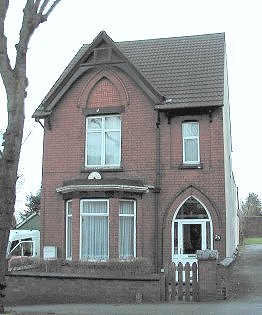
Harry Stevens' House in Oaklands Road |
When the country went to war in 1914, radio amateurs
were considered to be a security risk, and so the Post Master General
ordered all wireless transmitters and receivers in private hands to be
dismantled.
This came as a blow to Harry, who was slow to comply with
the order. His neighbours suspected him of communicating with the enemy
and contacted the local police. Reluctantly he had to remove his
equipment.
In those days thermionic valves were in their infancy, in
fact they were not perfected until after the outbreak of war. At this
time Harry probably used a spark transmitter to send morse code,
although speech transmissions were being carried out at the time using a
high frequency alternator operating at about 80KHz. Whichever form of
apparatus he used, he probably designed and built it himself. |

After the war Harry continued his transmissions. Components
and valves soon became readily available, and so Harry was able
to experiment with the new technology. His brother Joe Stevens
junior, lived at the other end of Oaklands Road, and he also had
a wireless receiver. At this time Harry was transmitting speech
and Joe and his family used to listen to Harry's transmissions.
It took him two years to complete his radio station. His call
sign was 2SY. Around this time Harry built a chiming clock which
was featured in an article in the 'Model Engineer', written by
'A.J.S.' On Wednesday 1st March, 1922 the Wolverhampton and
District Wireless Society held its first meeting. At the meeting
the officers and committee were elected and Harry joined the
committee. The Chairman, Mr. H. H. Speke, had a toy and book shop
at number 26 King Street and meetings were held on Wednesday
evenings at 7.30p.m., in a room behind the shop.
|
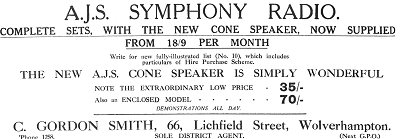 |
An advert from
the Bilston Weekly of 25th November. 1927 |
| On 27th April, 1922, a public concert and demonstration of
radio was held at the A.J.S. works. It was advertised in the
local press and radio shops as a demonstration of Wireless
equipment and choral evening. In 'Wireless World' the
venue was described as the works mess room and in the 'Model
Engineer' as the works assembly room. Whichever room it was, had
a small stage at one end and was quite large. About 100 people
attended and enjoyed the evening's entertainment, that included
a wireless demonstration followed by singing. Harry Stevens was
in the chair for the evening and the following artists
performed: |
John Bourne - a writer on the
staff of the Express & Star
Ethel Davies
Arnold Devey - local Post Office Wireless Inspector
Stanley Eaton
Maud Morgan
Elsie Turton |
| All of the artists except for Arnold Devey formed a
group of amateur singers. During the interval there was a
demonstration of a loop aerial. For the wireless
demonstration, the singers retired to a separate room and
performed in front of a microphone. They were clearly heard
in the concert room. |
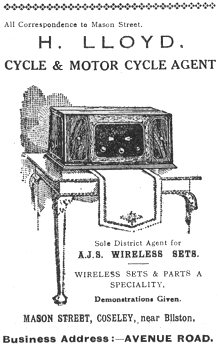
An advert from the Bilston Weekly of 17th June.
1927. |
Also during 1922 an exhibition of home built receivers
took place at the A.J.S. works canteen. About 20 members of the society
entered equipment, which was judged by Harry Stevens and Harold Taylor,
a radio amateur and an A.J.S. employee.
One Sunday morning in late 1922 or early 1923,
radio enthusiast James Dunn broadcast a musical concert on his English
baritone concertina from Harry's home radio station.
On Sunday mornings
Harry used to broadcast to other local amateurs such as Harold Taylor,
of the Lodge, Tettenhall, whose call sign was 2KQ, Reg Adams, of
Walsall, who had call sign 2NO and Rudge Littley, of Lodge Road, West
Bromwich, whose call sign was 2NV.
During one of these sessions plans
were made for the setting up of the 'Transmitters Society', which was
formed in the mid 1920s. Other local amateurs were H. Berry, of Lea
Road, E. Marlow, of Penn Road, J. V. Rushton, of Mount Road, J. A. H.
Devey, of Great Brickkiln Street and A. A. Devey, also of Great Brickkiln
Street. |
The History
of Radio |
 |
| By 1922 commercial radio had taken off in America and it was
obvious that the same would happen here.
Early in the year,
the B.B.C. was formed and regular broadcasts began before
the year ended.
Harry envisaged a large new market for
wireless receivers (due to the great demand for them in the
USA) and so he pressurised the A.J.S. board, and got them to
accept the idea of manufacturing A.J.S. receivers. |
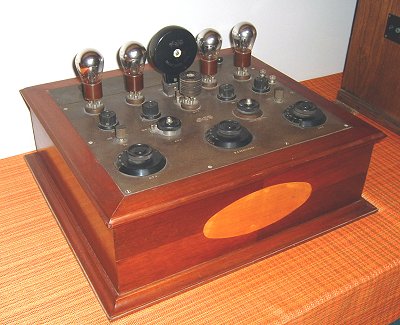
One of the company's first
receivers, the table model from 1923. Courtesy of Joris
Van Campenhout of the Olens Radiomuseum in Belgium. |
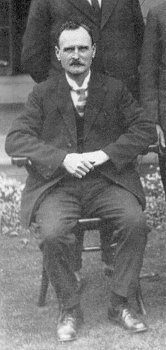
Harry Stevens, the man who made it all possible.
An enlargement from one of Geoff Stevens' photographs. |
New buildings were added at Lower Walsall
Street for wireless manufacture, and the wireless department became
known as A.J.S. Wireless and Scientific Instruments.
Harry soon designed
a 4 valve T.R.F. receiver, with a high frequency stage, a detector
and a two stage audio amplifier. Four models were launched in 1923, all
aimed at the top end of the market. The cheapest model, the 'Sloping
Panel' sold for £30.17s.6d. and the top of the range model, the
'Pedestal', housed in a free standing cabinet, with internal horn
loudspeaker, sold for £75. There was a lot of public interest in
wireless, and by October 1923, 500,000 licences had been issued.
Five new models were released in 1924 with an overall reduction in the
selling price. They were all T.R.F's, and prices varied from £17.10s.0d
for a simple two valve receiver to £52.10s.0d. for the 4 valve pedestal
receiver.
In July the royalties that had been paid to members of the B.B.C. were scrapped, and foreign manufacturers were allowed to sell
their products here. This meant that British manufacturers now faced a
lot of competition and so prices were again reduced.
A.J.S. decided to
display their products at the September 1924 Wireless Exhibition, at the
Royal Albert Hall, in London. They were joined by 55 other
manufacturers, and the exhibition attracted over 46,000 visitors. |
| The A.J.S. wireless receivers were
well received and attracted a lot of attention. As a result
several new dealers were appointed in London. Sales were good
and the receivers were gaining a reputation for quality and
reliability. They had external valves so that they could be
easily replaced as required. Valves at this time had a
relatively short life. The company opened its own radio
station, broadcasting from Lower Walsall Street Works. Most of the programmes consisted of music,
presumably as a way of helping to sell the receivers. |
For the technically minded
-
Some A.J.S. products inside out |

|
|
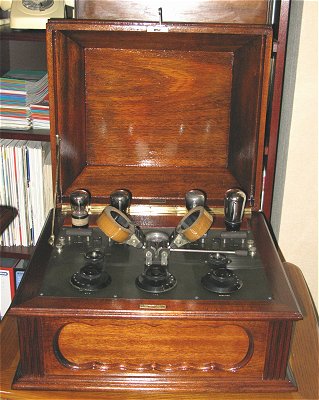
A type 'F' from 1924. |
| In 1925 the number of models increased to 10, and prices
varied from £13.18s.6d for a 2 valve receiver, to £51.18s.0d for the
pedestal model, with internal horn loudspeaker. Sales continued to
increase, and so extra factory space was required to increase
production. As space was available at the Stewart Street works, it was
utilised for the wireless cabinet making department.
A new sound proof
demonstration area was also added at Lower Walsall street, so that
dealers could see the new receivers working in ideal conditions. On 10th
September new showrooms and offices were opened at 122-124 Charing Cross
Road, London, in time for the Wireless exhibition.
The 1925 exhibition
was much bigger than in the previous year. There were no fewer than 109
exhibitors, and A.J.S. also displayed its range of accessories including
horn loudspeakers and headphones.
At this time the number of licence
holders had risen to over one and a half million. A.J.S. also had an
office and showrooms at 240-250 Great Western Road, Glasgow, and dealers
in Australia, New Zealand, India, Siam and South Africa. |
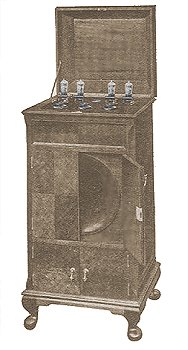
An A.J.S. Pedestal Receiver
|
| The beginning of 1926 wasn't a good time for A.J.S., as
the company's sales were falling, mainly due to the rapid
developments that were taking place in the industry. |
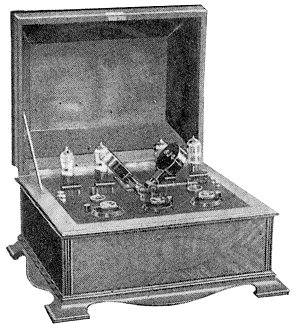
|
An A.J.S. Table Model. Photo courtesy of John
Chapman. |
|
Superhets appeared in America in 1924. These are like
modern receivers and only need very simple tuning controls. They also
offer a much better performance than can be obtained from the relatively
simple T.R.F. receivers that A.J.S. had so far produced. The superhets
also looked much better than the earlier receivers, as everything was
hidden inside the cabinet. No valves were showing, and they were much
easier to operate due to the simple tuning controls.
Something had to be done if A.J.S. was to retain its position in the
market, and so a whole new range of modern looking receivers including
two superhets was rapidly developed.
The new receivers were called
the Symphony range. There were two superhets and three cheaper T.R.F.
receivers including a portable. |
| Prices ranged from £17.10s.0d. for the
simple two valve, T.R.F., 'Symphony Two' to £67.10s.0d. for the
seven valve 'Symphony Seven' superhet. The range also included
the 'Symphony Five' which was a five valve, small portable
T.R.F. receiver, with internal frame aerial and loudspeaker. It
sold for £22.10s.0d. The manager of the radio section was Mr.
Wilson, who later went on to become Managing Director of
Reproducers and Amplifiers Ltd., in Frederick Street. |
| Read about the factories |
 |
| Sales were initially good, but the seasonal nature of
the industry meant that A.J.S. had to occasionally lay-off some of the
workforce. In an attempt to retain the workers during the slack periods,
the company started to produce the innovative 'Cobra' electric fire.
When standing upright it was a standard electric fire, but when lying on
its back with the heating element facing upwards, it could be used as a
small cooker, to maybe boil a kettle of water. Not many were produced
and its doubtful if any have survived. The name came from the shape of
the heating element. |
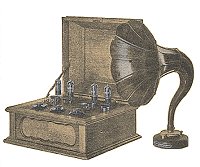
|
An A.J.S. table receiver and horn loudspeaker |
|
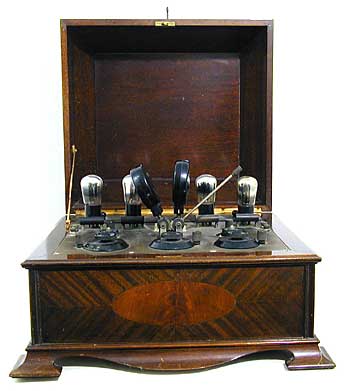
An A.J.S. type 'F' table model. Courtesy of
Steve Harris of On the Air Limited. |
Some of the A.J.S. adverts were extremely clever. An
example of this can be seen in the Illustrated London News of 12th
December, 1925. The company's advert featured a stereo anaglyph
showing a type 'F' table model and horn loudspeaker in a customer's
house.
To view the stereo image a suitable viewer with a red and
green filter is required. This could be obtained by requesting a
copy of the latest sales literature. |
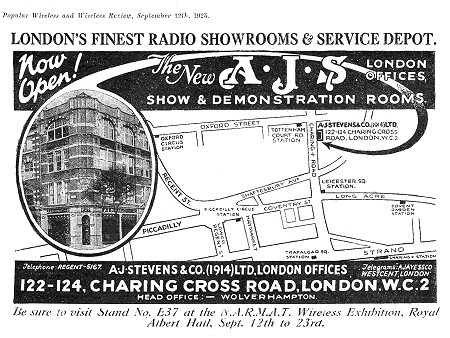
Advert courtesy of Joris
Van Campenhout.
| If you would like to view the anaglyph in stereo and
have a suitable viewer with a red and green filter, click on the
button below. This will download the anaglyph which is rather large
(166K). This may take some time if you have a slow internet
connection.
To correctly view the image, hold the viewer with the red
filter in front of your left eye and the green filter in front
of your right eye.

View the anaglyph
|
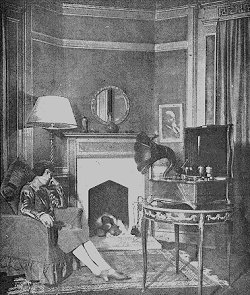
A black and white version of the stereo
image in the advert. |

Wireless Department staff in 1924. Courtesy of Jim
Boulton.

Some of the A.J.S. components
|
Wireless receiver prices were still falling in late
1926, and in order to compete, A.J.S. had to adopt mass production
techniques for the receivers. A predominantly female workforce was
employed, as it was considered that they were more suitable than men for
the delicate, repetitive work, and were cheaper to employ.
Even after
these measures were taken, sales did not improve. One problem with the
receivers was that they were battery powered, A.J.S never produced a
mains powered receiver. Mains receivers first appeared in August1926 and
many manufacturers offered mains adaptors for their battery powered
receivers. |
| By the summer of 1927 sales of the company's
receivers were falling, mainly due to increased
competition, and the introduction of cheaper
mass-produced radios. At the time the sales of A.J.S.
motorcycles and sidecars were also falling. Charles
Haywood secured a contract for A.J.S. to build car
bodies for Clyno cars at Lower Walsall Street, which was
seen as a way of securing the factory's future. The A.J.S. Board thought that diversification
might be a way of securing the company’s long term future
and so decided to develop a range of commercial
vehicle chassis at Lower Walsall Street, under Charles
Hayward’s supervision.
As a result the wireless department moved from
Lower Walsall Street to Stewart Street Works to free-up
space required for building the car bodies, and for
developing commercial vehicles. |
|
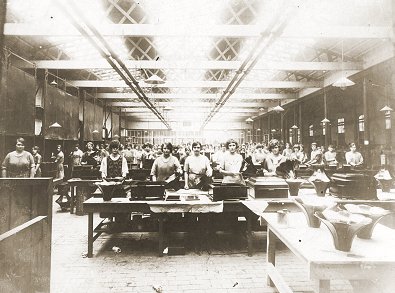
The radio cabinet shop at Stewart
Street in 1925. |
| Receivers were rapidly becoming more
complex, and as a result the public expected a very high
performance from a receiver. A.J.S. was failing to keep up to
date with the latest technology, and the receivers were starting
to look old fashioned when compared to the latest designs.
A.J.S. decided to give-up production in 1928, and sold the
Stewart Street works, the machinery and the remaining stock of
components to the Symphony Gramophone and Radio Company. The
sale took place on 30th October, 1928 with a selling price of
£15,375. The new company soon began producing radio receivers,
radiograms and loudspeakers.
|
Sadly Harry's Stevens' dream of becoming a major player in the
new radio industry didn't materialise. The market had become
very competitive and A.J.S. would have needed a lot of
investment in order to compete with the larger manufacturers.
Harry died at home on 19th January, 1954.
|
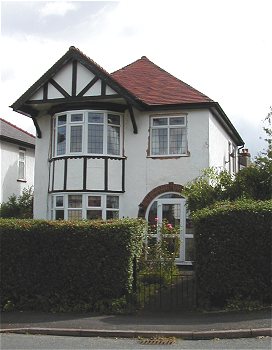
Harry Steven's final home in Windsor Avenue. |
|
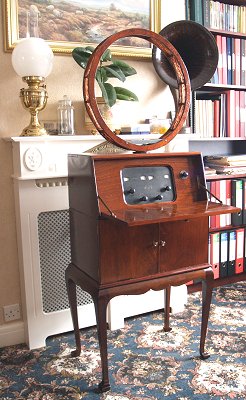
One of the later receivers, a Symphony
Seven. |
A Complete list of A.J.S.
Wireless Receivers
| Year |
Model |
Cabinet Type |
Finish |
Dimensions in inches. LxWxH |
Number of valves
|
|
1923 |
Table model |
flat table
top. |
Oak, walnut
or mahogany |
18.5x16.5x12 |
4 |
| Sloping
Panel |
Exposed
sloping panel face |
Oak, walnut
or mahogany |
17x9x13.5 |
4 |
| Table De
Luxe |
Enclosed
table top |
Oak or
walnut |
18.5x16.5x12 |
4 |
| Pedestal |
Free
standing with enclosed horn and battery compartment |
Oak or
mahogany |
21x19.25x43.5 |
4 |
|
1924 |
Type D |
Exposed
sloping panel face |
Walnut or
mahogany |
13.5x8.5x11 |
2 |
| Type E |
Exposed
sloping panel face |
Walnut or
mahogany |
15.5x9x12.5 |
3 |
| Type F |
Exposed
sloping panel face |
Walnut or
mahogany |
17x9x13.5 |
4 |
| Type F |
Enclosed
table top -Unitop |
Oak, walnut
or mahogany |
20x17.5x12 |
4 |
| Type F |
Free
standing with enclosed horn and battery compartment |
Oak or
mahogany |
21x19.25x43.5 |
4 |
|
1925
|
Type Z |
Enclosed
table top with exposed front panel |
Mahogany |
14x9x11.25 |
2 |
| Type D6 |
Exposed
sloping panel face |
Oak or
mahogany |
13.5x8.5x11 |
2 |
| Type E6 |
Exposed
sloping panel face |
Oak or
mahogany |
15.5x9x12.5 |
3 |
| Type F6 |
Exposed
sloping panel face |
Oak or
mahogany |
17x9x13.5 |
4 |
| Type T.M.1 |
Enclosed
table top |
Mahogany |
21.25x19.5x13.25 |
4 |
| Type T.M.2 |
Enclosed
table top |
Oak or
mahogany |
21.25x19.5x13.25 |
4 |
| Pedestal P1 |
Free
standing with enclosed horn and battery compartment |
Mahogany |
21x19.25x43.5 |
4 |
| Pedestal P2 |
Free
standing with enclosed horn and battery compartment |
Oak or
mahogany |
21x19.25x43.5 |
4 |
| Console S1 |
Free
standing with enclosed horn and cupboards |
Mahogany
and rosewood |
39x21x39 |
4 |
| Unit
Pedestal |
Free
standing 3 piece unit with enclosed horn and battery compartment |
Oak or
mahogany |
21x19.25x43.5 |
4 |
|
1926 to 1928
|
Symphony
Two |
Lidded with
exposed controls |
Mahogany
|
22x14x11 |
2 |
| Symphony
Three |
Lidded with
exposed controls |
Mahogany |
22x14x11 |
3 |
| Symphony
Five |
Lidded with
exposed controls |
Mahogany |
23.25x15.5x21.5 |
5 |
| Symphony
Five |
Free
standing lidded with exposed controls |
Mahogany |
23.25x15.5x39.5 |
5 |
| Symphony
Seven |
Lidded with
exposed controls |
Mahogany |
23.25x15.5x21.5 |
7 |
| Symphony
Seven |
Free
standing lidded with exposed controls |
Mahogany |
23.25x15.5x39.5 |
7 |
| Symphony
Five |
Portable
with carrying handle |
Oak |
16x8.5x13.5 |
5 |
The 1923 models included 2, 3, and 4
valve versions of the receivers listed above.
A note for would-be purchasers of
A.J.S. receivers.Many A.J.S.
receivers have survived and occasionally come up for sale. They
can be found at vintage radio fairs, old radio dealers, antique
dealers and on the internet on such websites as ebay. A.J.S.
receivers often interest collectors and can fetch high prices.
Over the last two years I have seen many A.J.S. radios for sale,
but two of them were not the genuine article and so care is
necessary when considering a purchase. A.J.S. receivers were
always built to the highest standards and are housed in quality
wooden cabinets, anything that is not should be treated with
suspicion. Top quality components are used throughout and front
panels are always nicely lettered and labelled. If you come
across any A.J.S. radio for sale that is not listed in the above
table, or does not match the specification, it is probably not
the genuine article, so please be careful.
|

|
If you own an A.J.S. receiver, amplifier or loudspeaker and
have any photographs or circuit details that I can include here
please email me.
I would like to thank the late Geoff Stevens, the late Jim Boulton, Ray
Jones, Ian Higginbottom, Joris
Van Campenhout, and Gorm Helthansen for all of their help in
preparing this section.
|
|
 |
Return to
the List
of Manufacturers |
|

